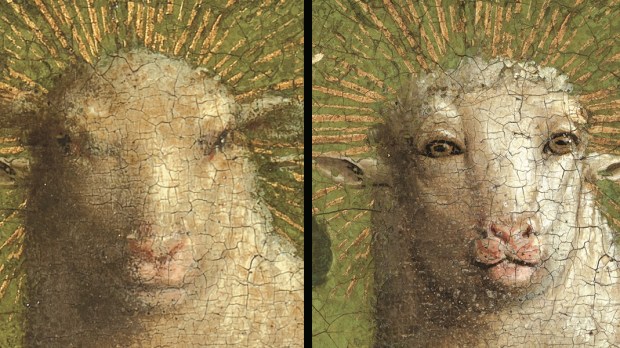Lenten Campaign 2025
This content is free of charge, as are all our articles.
Support us with a donation that is tax-deductible and enable us to continue to reach millions of readers.
One of the most profound symbols of Jesus Christ is the “Lamb of God,” the animal to be sacrificed in the tradition of the lamb offered by the ancient Hebrews in expiation of their sins.
And one of the most celebrated images of that symbol was painted in the 15th century by the Flemish brothers Jan and Hubert Van Eyck. The “Adoration of the Mystic Lamb,” the centerpiece of a 12-panel masterpiece, the Ghent Altarpiece, is set to return to its home at St. Bavo’s Cathedral in Ghent, Belgium on January 24, along with four other panels that have undergone a three-year treatment.
The restoration involved peeling off layers of paint that were added on top of the original—overpainting—and has revealed marvelous details.
Since October 2012, Belgium’s Royal Institute for Cultural Heritage (KIK-IRPA) has led a €2.2m altarpiece conservation project, within a specially constructed laboratory at Ghent’s Museum of Fine Arts.
“Despite the wealth of prior research conducted on the altarpiece, it was only during the KIK-IRPA restoration that scientists made an astonishing discovery: beneath the layers of yellowed and cloudy varnish, around 70% of the outer panels was obscured by 16th-century overpainting,” The Art Newspaper reported.
“This overpainting had been done so early on, and following the shapes of the original, with very similar pigments that had also aged in a similar way, that it was not actually visible on the technical documentation when the altarpiece first came in for treatment,” recalls Hélène Dubois, the head of the restoration project. “And nothing like this had ever been observed on early Netherlandish painting.” The discovery came as “a shock for everybody—for us, for the church, for all the scholars, for the international committee following this project,” she says
Stripping away the overpainting was “a painstaking process using solvents and surgical scalpels,” the publication said.
But what was revealed will change the way people see the work, which the Van Eyck brothers painted from the mid-1420s to 1432. The most striking change is the face of the lamb itself:
Most surprising of all was the lamb’s humanized face, which emerged beneath its more animal 16th-century appearance. The original lamb has a more “intense interaction with the onlookers,” Dubois says, adding that art historians and theologians will continue to research why the Van Eycks chose this “cartoonish” depiction—a striking departure from the painting’s precise naturalistic style. “Botanists can actually identify every plant in there,” Dubois points out. “The ones that couldn’t be identified—those were overpaintings.”
The eight outer panels, restored during a first phase from 2012 to 2016, will come back to the museum in February, as exceptional loans for an exhibition in honor of Ghent’s “Year of Van Eyck.”
The restoration will continue into a third phase that tackles the upper sequence of interior panels, possibly beginning in 2021, The Art Newspaper said.

